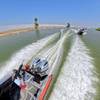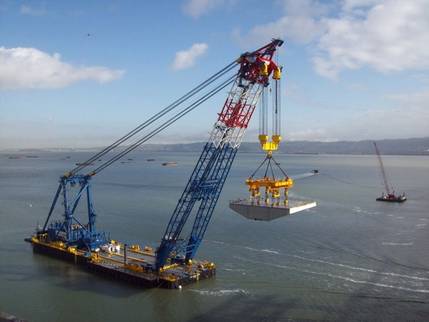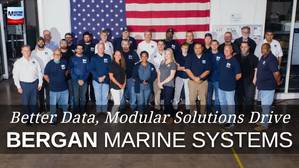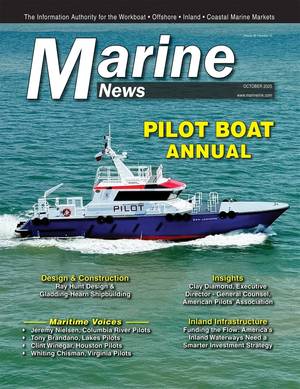PVA:Moving Cargo, Passengers to the Water
Coastwise Liner Trades
Recent highway "gridlock" on major sections of the U.S. interstate highway system, coupled with projections for the growth of U.S. container commerce over the next decade and beyond, has focused attention on the need to augment highway and rail facilities with a waterborne alternative. The I-95 and I-5, Atlantic and Pacific Coast, corridors present the most serious current and projected problems. On the Atlantic Coast, on-shore delays in container deliveries sometimes now exceed the number of days involved in the container's Atlantic crossing. Parallel, currently unused, water routes between major East Coast metropolitan centers could offer cost-effective, practical, alternative means of transportation between many of the locations involved.
For I-95 much of the attention has been focused on the transport of sea containers coming into the U.S. at a port like Port Newark, which are then moved up or down the Atlantic Coast by truck. In fact, the more important problem on I-95 is with the purely domestic moves in 53 ft. trailers. Removing these trailers from I-95, and from the metropolitan bypasses like I-495, would materially alleviate congestion. It would reduce the potential for accidents. Air quality would also be a major benefactor. Trailers with hazardous materials transported in this fashion would be removed from bridge and tunnel transit as well as bypassing major metropolitan centers.
The most immediate problems blocking this development are said to be the cost and lack of shore-side infrastructure and high capital cost of new vessels. The infrastructure problem appears materially overstated. Most of these movements will be by container or RoRo barges or self propelled RoRo vessels, with distance dictating the choice between barge and vessel. Existing technology should allow either class of vessel to avoid expensive container handling facilities and make use of existing infrastructure and roadstead sites.
With the proper choice of used equipment, operators might initially avoid some of these high capital costs. Some barge operators are exploring the conversion of OPA 90 obsolescent single hull tank barges. The TOTE and Matson Navigation owned 1970's built RoRos, which will soon be redundant to these companies' operations, could find a home here as low-cost tonnage in start-up services. Once the utility of these RoRo barge and vessel services is proven, more efficient tonnage could be purchased and introduced.
But new efficient RoRo designs will be needed for some services. There is a clear need for the Coastwise "W-95" services, with obvious opportunities for our operators and shipyards. The question, which remains, is "How are these RoRo purchases to be funded?" Where is the equity to be found, or how is it to be accumulated? Will debt financing matched to vessel useful lives be available? Or will the debt be subject to repayment over some shorter period such as one-half of a vessel's life?
Passenger and RoRo/Passenger Ferries
Passenger ferry services were largely abandoned after WWII as the result of inexpensive auto transport and fuel costs, and of extensive U.S. government-funded highway systems. Now, traffic congestion, and the capital and environmental costs of new highway, bridge and tunnel construction, have called into question the practicality of further significant expansions. "They will" as they say "never build another Holland Tunnel." Passenger ferry services offer immediate and expanding opportunities.
The past decade has witnessed the reintroduction of passenger ferry services in selected urban locations like New York and Boston after a 30 or more year hiatus. In New York City prior to the events of September 11 non-subsidized ferry operators were providing 30,000 passenger trips per day between Manhattan and multiple locations in northern New Jersey. Today, New York City passenger carriage figures are more than double this figure. And, the City has announced plans for the development of a regional passenger ferry transportation plan and the construction of what The New York Times has described as a "fleet" of new ferry terminals.
Ferries have been in operation on San Francisco Bay for more than 150 years, with over 30 major ferry routes in service at one time or another. San Francisco commuter ferry services were never entirely discontinued after World War II. The past three decades have seen an ever-expanding re-institution of various cross Bay services to provide commuting alternatives to the bridges and the Bay Area Rapid Transit system. A San Francisco Bay Area Water Transportation Authority has been established to plan and manage the expansion of high-speed ferry service for the Bay Area's 21st Century.
The Washington State Ferry System, the largest volume passenger and vehicle system in the nation, meets essential transportation needs and provides complementary services which have themselves become a major tourist attraction. New ventures are underway for Alaska, for the Seattle region, and for various Coastal and U.S. Great Lakes routes.
For passenger ferry services new construction is the rule. U.S. shipyards have proven to be efficient builders of stable mono-hull and catamaran platforms with vessel speeds and sizes appropriate to the services in which the vessels are to be employed. Higher speed designs are regularly introduced and new low wake designs are being proven effective. These and other developments open new opportunities for ferry transportation, and ferry vessel newbuildings should provide important work for a number of the so-called "second tier" U.S. shipyards. From every standpoint, from out-of-pocket costs to the taxpayer, to protection of the environment, the logic favoring the addition of these passenger ferry services is compelling.
As was the case with new RoRo tonnage, the question, which remains, is "How are these ferry vessel purchases to be funded?" Where is the equity to be found, or how is it to be accumulated? Will debt financing matched to vessel useful lives be available? Or will the debt be subject to payment over only one-half of a vessel's life? For a number of the new ferry services, which are under contract or in discussion with private sector purchasers, the availability of MarAd Title XI financing guarantees appears to be an essential element.
Financing Needs
Shipowner and shipbuilder opportunities depend upon national transportation needs, and upon financing for the projects which shipowners and shipbuilders will be able to craft to meet these needs. Historically, maritime transportation projects have generally not provided sufficient security or returns adequate to attract substantial private sector equity investment or long term debt financing.
Many of the vessels now in service in our U.S. trades are over 25 years in age. There is no reason to expect shorter lives for vessels built to meet 21st Century coastwise transportation needs. Commercial asset-based vessel financing, when available, will generally be limited to a term of no more than 10 to 12 years, or less than one-half the vessel lives. Such financing will almost double annual debt service requirements in the early transaction years. This will increase the cost of the transportation service to be provided -- be it for the coastwise movement of a 53-ft. trailer, or a ferry fare for a work-bound commuter, by the same multiple.
In many cases, this "doubling" of the cost of service to be provided will defeat a business plan finding of "economic viability." So, where will the long term debt financing necessary to properly fund these transactions be found? And, where will we find the equity?
MarAd Programs
Originally put in place under the Merchant Marine Act, 1936 (the "1936 Act"), the MarAd Title VI and Title XI Programs were intended to meet this very same set of problems as they existed in 1936.
In their revised forms under the Merchant Marine Act of 1970, and the Federal Ship Financing Act of 1972, the MARAD Capital Construction Fund ("CCF") and Title XI financing guarantee programs enable qualified operators: (i) to accumulate the equity on a tax deferred basis over a period of up to 25 years under CCF program contracts; and (ii) to access private sector commercial vessel financing for up to 25 years by means of a U.S. government program of financing guarantees.
So we have well-established national water transportation needs, which will require as much as $1 to $2 billion in new vessel construction over the balance of the current decade. There is an established need for equity funds for these projects, and for accessing long term debt matched to project lives.
Existing U. S. operators have approximately $1.4 billion of their own monies already set aside for U.S. vessel construction under MarAd CCF program contracts. And, there is a "public-private partnership" program of MarAd financing guarantees that has afforded U. S. operators access to long term private sector financing for over 60 years at no cost, or at very little cost, to the federal government.
However, access to these MarAd programs is currently being denied by the Bush Administration Office of Management and Budget that: (1) refuses to allow a change in the CCF program that would allow these operators to use $1.4 billion of their own monies to contract for vessels to be engaged in coastwise service; and (2) seeks to discontinue the Title XI financing guarantee program for accessing long term private sector debt financing matched to vessel lives.
The Department of Transportation is currently crafting a national transportation policy to meet the our 21st Century needs.
The MarAd CCF and Title XI programs appear well suited for a place in this developing mosaic. However, Department personnel do not appear to seek their inclusion. And, there is as yet no indication of any change in the OMB position which blocked the use of the CCF program for vessels in our coastwise trades, or in OMB's apparently continuing efforts to entirely discontinue the Title XI program.
It is agreed that our highway congestion problems are increasing and cannot be solved by additional highway construction or increased rail services. It is agreed that waterborne transportation of passengers and cargoes offers the only practical means for congestion relief. But while the need for water transport is clear, and the means of financing the needed vessels using existing MarAd programs is at hand, this solution continues to elude DOT and OMB planners.
And, to date, neither DOT nor OMB have proposed alternative means for accessing the equity and long term debt needed to fund the new vessel construction necessary to meet these 21st Century coastwise transportation needs.
H. Clayton Cook, Jr., BS Princeton University, LL.B The University of Virginia, is a Senior Counsel in the Washington, D.C. offices of Fulbright & Jaworski L.L.P. Mr. Cook served as General Counsel of the Maritime Administration during the Nixon and Ford Administrations and oversaw the implementation of the Capital Construction Fund provisions of the Merchant Marine Act of 1970, and the drafting of the Federal Ship Financing Act of 1972. He has had more than 30 years of experience in advising domestic and foreign clients on the construction and financing of U.S. flag vessels in transactions totaling more than $3 billion. Mr. Cook's email address is [email protected]"













